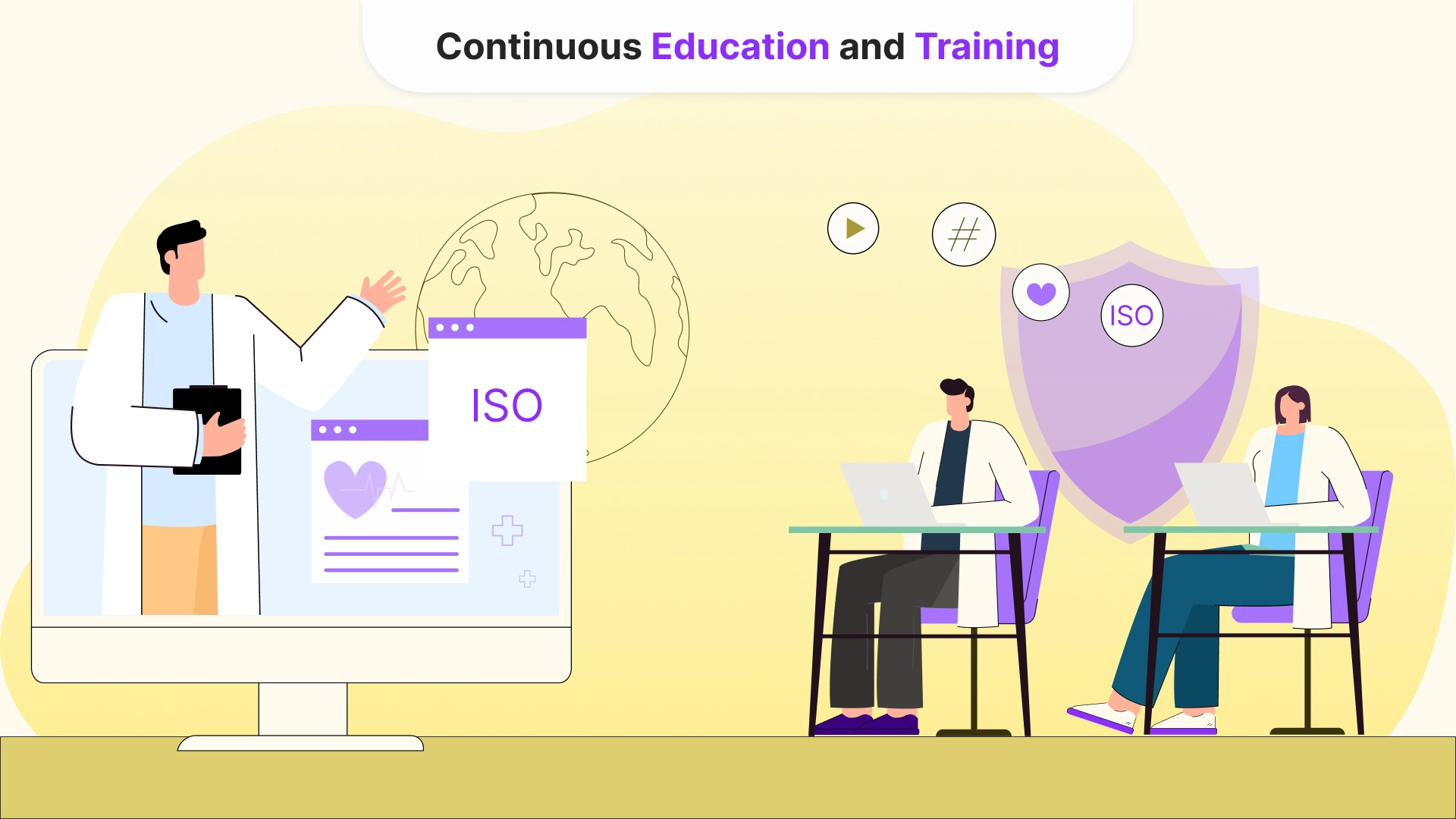

Overview of Major International Medical Device Standards
In this article, we’ll cover the major international standards that govern medical devices, the importance of compliance, and practical steps for achieving regulatory adherence.
ISO 13485:2016
Purpose and Scope
ISO 13485:2016 outlines the requirements for a quality management system (QMS) where organizations demonstrate their ability to consistently provide medical devices and related services that meet both customer expectations and regulatory requirements.
This standard applies to various stages of a medical device’s life cycle, including design and development, production, storage, distribution, installation, and servicing.
It also encompasses associated activities, such as technical support.
Applicability
ISO 13485:2016 is relevant to organizations of all sizes and types, except where explicitly stated otherwise.
When requirements are specified for medical devices, they equally apply to associated services provided by the organization.
ISO 14971
Purpose and Scope
ISO 14971 provides a structured approach to identify, assess, and manage risks associated with medical devices.
It encompasses not only physical devices but also software used in healthcare and in vitro diagnostic devices.
The primary objectives are to enhance patient safety, minimize adverse events, and ensure the effectiveness of risk control measures.
Applicability
The requirements outlined in ISO 14971 apply to all phases of a medical device’s life cycle. Whether during design, production, distribution, or post-market surveillance, risk management remains paramount.
The standard addresses a wide spectrum of risks, including those related to biocompatibility, data security, electricity, moving parts, radiation, and usability.
It extends its reach to products that may not strictly qualify as medical devices in certain jurisdictions. However, it does not cover clinical procedure decisions or broader business risk management.
ISO 62304:2006
Purpose and Scope
ISO 62304:2006 defines the life cycle requirements for medical device software.
It establishes a common framework for managing the software life cycle processes in the context of medical devices.
The standard encompasses the development and maintenance of software that either constitutes a medical device itself or serves as an embedded/integral part of the final medical device.
Applicability
This standard applies when:
software is a standalone medical device;
software is an embedded component within a medical device;
software is used in the production of a medical device;
software is the device itself (such as Software as a Medical Device or SaMD).
FDA Regulations for Medical Devices
Purpose & Scope:
The FDA classifies medical devices into three categories: Class I, II, and III. The classification regulation defines the requirements for each device type. Most Class I devices are exempt from Premarket Notification 510(k); most Class II devices require Premarket Notification 510(k); and most Class III devices necessitate Premarket Approval.
Manufacturers (both domestic and foreign) and initial distributors (importers) of medical devices must register their establishments with the FDA. This includes various entities such as contract producers, sterilizers, repackagers, and developers of accessories. Even U.S. manufacturers of “export only” devices fall under this requirement.
If your device requires 510(k) submission, commercial distribution is contingent upon receiving FDA authorization.
Adherence to quality system requirements ensures consistent product quality. Manufacturers must follow current good manufacturing practices (CGMP).
Producers must promptly report adverse events related to their devices. This reporting system helps monitor safety and effectiveness.
Applicability:
Compliance with FDA standards is often viewed as essential for most markets worldwide. It ensures alignment with international safety norms.
While the FDA ensures safety, it doesn’t guarantee device effectiveness. Evidence of effectiveness is required for premarket approval.
IEC 60601
Purpose and Scope
The IEC 60601 series of technical standards is a beacon for ensuring the safety and essential performance of medical electrical equipment.
The cornerstone of this series is IEC 60601-1, aptly titled Medical Electrical Equipment – Part 1: General Requirements for Basic Safety and Essential Performance. It lays down fundamental safety principles applicable to all medical electrical devices. Compliance with this standard has become a prerequisite for commercializing electrical medical equipment in numerous countries.
Within the IEC 60601 series, certain terms are capitalized, signifying their specific definitions. For instance, ME EQUIPMENT refers to equipment intended for diagnosis, treatment, monitoring, or disease alleviation. It may have up to one power connection and can be battery-operated. Additionally, APPLIED PARTS are components that come into physical contact with the patient during normal use.
Applicability
IEC 60601-1 serves as a widely accepted benchmark for medical electrical equipment. Companies often view compliance with this standard as essential for most markets.
While IEC 60601-1 ensures safety, it doesn’t guarantee the effectiveness of a medical device. In the US, the FDA requires evidence of effectiveness through premarket approval or similarity to a predicate device.
The IEC 60601 series includes collateral and particular standards. These may override or modify requirements based on specific product types.
Importance of Compliance
Compliance with these standards is critical for several reasons:
Patient Safety: Standards ensure that medical devices meet safety and efficacy requirements, minimizing risks to patients.
Market Access: Regulatory bodies often require compliance for market approval. Without it, manufacturers may face barriers to entry.
Quality Assurance: A robust QMS enhances product quality, reduces defects, and fosters customer trust.
Legal and Financial Implications: Non-compliance can lead to legal penalties, recalls, and reputational damage.
Achieving Compliance and Ensuring Patient Safety
Achieving compliance with medical device standards is a multifaceted process that requires dedication and attention to detail. It encompasses various aspects, each playing a crucial role in ensuring patient safety and the quality of healthcare delivery.
Continuous Education and Training

Engage in continuous education through workshops, webinars, and conferences focusing on medical device regulations. Keep your team up to date on compliance requirements, risk management strategies, and quality assurance practices to maintain a culture of compliance within your organization.
Implementing a Robust Quality Management System
A comprehensive QMS aligned with ISO 13485 standards forms the backbone of regulatory compliance for medical devices. Establishing and maintaining robust document control procedures ensures proper management of documents, procedures, and records throughout the device lifecycle. Implement effective change management protocols to systematically assess and implement changes, ensuring their impact on device safety and efficacy is thoroughly evaluated. Utilize corrective and preventive action (CAPA) processes to address non-conformities promptly and prevent their recurrence. Regular internal audits help identify areas for improvement and ensure ongoing compliance with regulatory requirements. Proper supplier management protocols should be in place to evaluate and monitor suppliers' compliance with regulatory standards.
Integration of Risk Management Practices
Conduct thorough risk assessments during design, development, manufacturing, and post-market phases. Document risk control measures and monitor their effectiveness to ensure continuous improvement in device safety and performance.
Validation and Verification Processes
Validate and verify that the medical device meets its intended purpose through rigorous testing and assessment. Conduct validation activities to confirm the device's performance under real-world conditions. Verify that design specifications are met during the development process. Perform performance testing, usability studies, and functional assessments to ensure the device meets regulatory requirements and user needs.
Labeling and Packaging Compliance
Adhere to labeling requirements to ensure the safety, usability, and traceability of medical devices. Assign a unique device identifier (UDI) to each device for tracking and identification purposes. Use standardized symbols and warnings on labeling to convey important information to users. Provide clear and comprehensive instructions for device use in the instructions for use (IFU). Ensure packaging integrity to protect the device during storage and transportation, minimizing the risk of damage or contamination.
Collaboration with Regulatory Bodies and Notified Bodies
Maintain open communication with regulatory agencies and notified bodies throughout the regulatory approval process. Seek pre-submission meetings to discuss your device and regulatory pathway, ensuring alignment with regulatory requirements. Involve notified bodies during the conformity assessment process, such as CE marking for the European market. Collaborate with regulatory experts to navigate complex regulatory landscapes and ensure compliance with evolving standards and regulations.
Post-Market Surveillance and Vigilance
Monitor the performance of medical devices after they enter the market to identify and address any issues promptly. Promptly report adverse events to regulatory authorities and investigate complaints thoroughly. Provide periodic safety updates based on ongoing surveillance activities to ensure continued compliance and patient safety.
As a Conclusion
If you decide to develop or you’ve already had a medical device, remember that compliance is not just a legal requirement; it’s about ensuring patient safety and delivering quality healthcare. Continuous education and training are vital for staying informed about regulations and updates. Implementing a robust Quality Management System aligned with ISO 13485 is crucial. Integrating risk management practices throughout the product lifecycle, maintaining thorough documentation, ensuring labeling and packaging compliance, and collaborating with regulatory bodies are all essential steps.
Faq
What are the major international standards that govern medical devices?
+The major international standards governing medical devices include ISO 13485, which outlines requirements for quality management systems specific to the medical device industry. ISO 14971 focuses on risk management for medical devices, ensuring that manufacturers identify, assess, and mitigate risks throughout the device lifecycle. Additionally, IEC 60601 specifies safety and essential performance requirements for medical electrical equipment and systems, ensuring their safe and effective use.
Why is compliance with medical device standards important?
+Compliance with medical device standards is crucial for ensuring the safety and effectiveness of medical devices used in patient care. It helps mitigate risks associated with device malfunction or failure, safeguarding patient well-being. Adherence to standards fosters trust among healthcare professionals and patients, promoting confidence in the quality and reliability of medical devices.
What is the role of regulatory bodies in ensuring adherence to these standards?
+Regulatory bodies play a critical role in ensuring adherence to medical device standards by evaluating devices against established criteria for safety, efficacy, and quality management. They guide manufacturers, conduct inspections and audits to ensure compliance, and take enforcement actions when necessary to maintain the integrity of the regulatory framework and safeguard patient safety. Regulatory bodies uphold standards and promote continuous improvement in medical device safety and quality through collaboration with stakeholders and ongoing monitoring of devices post-market.
How can medical device manufacturers achieve regulatory compliance?
+Medical device manufacturers can achieve regulatory compliance by implementing a robust Quality Management System aligned with relevant standards, such as ISO 13485. They should integrate risk management practices throughout the product lifecycle and maintain thorough documentation to demonstrate compliance with regulatory requirements. Collaboration with regulatory bodies, continuous education, and proactive monitoring of post-market performance are also essential to ensure adherence to regulations and promote patient safety.
Tell us about your project
Fill out the form or contact us

Tell us about your project
Thank you
Your submission is received and we will contact you soon
Follow us
